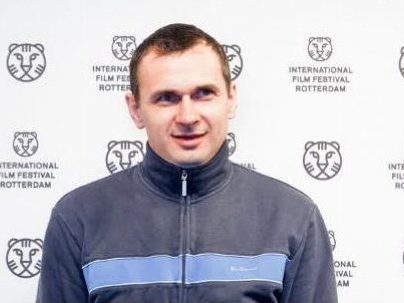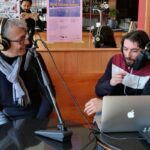Why Is Sentsov’s Strike So Important?
Oleksiy Radynski
I’m writing this text on the 110th day of a hunger strike that Crimean filmmaker Oleg Sentsov is holding in a Russian prison camp, demanding the release of all political prisoners from Ukraine currently detained in Russia. By the time this text is published, Sentsov might already be dead. And this is not the only reason why Sentsov’s case is so urgent that, speaking of the political dimension of art in my country, no other issue even deserves a mention[1].
The whole story of Sentsov’s arrest, trial and imprisonment is possibly one of the most extreme cases of ongoing confrontation of an artist with a newly emerging global mode of governance that operates under the logic of ‘alternative facts’. In the meantime, after more than four years of this artist’s imprisonment and more than three months into his hunger strike, relatively few people in the global art milieu had even heard of Oleg Sentsov. It’s therefore easy to get a false impression that we’re dealing with some kind of particularized single-issue struggle here. We’re not. (And blame for a lack of proper information outreach on Sentsov’s struggle should be squarely put on the dysfunctional Ukrainian artistic communities and institutions, not to mention Ukrainian government that had lost any credibility in the global public sphere by staging grotesque media stunts).
So, why is Oleg Sentsov so important? Let’s put it like this: the most obvious way to make a case for a statement like ‘post-truth kills’, is to look at the story of Sentsov.
In May 2014, shortly after the land grab of Ukraine’s Crimean Peninsula was completed by the Russian army, the occupying forces had detained the filmmaker Oleg Sentsov together with anti-fascist radical ecologist Sasha Kolchenko. The two were accused of plotting acts of terror in Crimea on behalf of the Ukrainian far-right group. They were kidnapped to mainland Russia, where they were stripped of their Ukrainian passports and – against their will – converted into Russian citizenship. They were then put on a show trial that was not based on any credible evidence – even by the standards of Russian judiciary. (And the standards of Russian judiciary had already been known as, let’s put it mildly, stretched). Sentsov and Kolchenko were found guilty and sentenced to 20 and 10 years of prison camps, respectively.
This story deserves a closer look. It resonates with a quite a few tactics and practices that now become the new normal for authoritarian regimes everywhere, far beyond Russia or Ukraine.
Initially, the calculation was clear: Grab an anti-fascist activist who is opposed to the military occupation of his land by the troops of a neighboring tyranny. Declare him a neo-Nazi bomber. You know, Antifa is violent, while ‘there are good people on both sides’.
To render any kind of political resistance futile, a good measure of confusion is needed. But a lone ‘neo-Nazi Antifa’ might not be enough for that. Some kind of a terror cell would do, though. Apart from Antifa, there’s other groups that are easy to scapegoat. Artists, for instance. Sometimes they tend to make trouble. But as soon as you lock one of them up, the rest suddenly turns silent (at least, Russian secret service thinks so, based on their longtime experience). So, grab an artist and declare him part of a terror cell.
And if that artist – like Oleg Sentsov – had participated in the anti-Kremlin Maidan uprising in Kyiv, that’s even better. The Russian mass media have been labeling that uprising as ‘fascist’ on a daily basis for the full three months of its duration. Few things in recent history had done more to normalize the word ‘Fascism’ than this day-to-day labeling. How did this work? Let me give an example. If someone you really despise calls you, say, ‘a basket of deplorables’, you’d be more than happy to appropriate that label. And what if someone you really despise calls you that every day for three months? You’d end up proudly having no problem with that definition at all. You will even stop having a problem with bunches of real deplorables, or real fascists, who are joining your movement.
But, at some point, the Sentsov-Kolchenko calculation failed. Their ‘terror cell’ was triumphantly jailed, ending any kind of resistance to Russian occupation of Crimea. But then there was a problem: the prisoner turned out not to be yet another member of the ‘creative class’ whom you can break with relative ease. Oleg Sentsov turned out to be a real artist. His feature film debut was premiered at Rotterdam Film Festival shortly before his arrest, and scores of important filmmakers started to bombard the Kremlin with requests of Sentsov’s release. His defiant speech in Russian court proved to be one of the most impressive verbal insults inflicted on Kremlin. And now – his hunger strike, conceived as an ultimate form of artistic protest.

The hunger strike was started roughly 60 days before the final game of a football World Cup in Russia, in order to cause the most possible damage to Putin’s regime. But Sentsov miscalculated, as well. The global media landscape has changed beyond recognition in the four years he’s been in prison, and the journalists – even those most critical of Russia – had so much fun at the World Cup that they didn’t bother to even mention Sentsov’s strike at all. Sentsov survived through the finals, as well as through the Trump-Putin summit where the US was one President’s tweet away from officially recognizing Crimea as Russian territory. It’s hard to see at the moment, though, how he will survive the two world leaders who are now turning Sentsov’s tragic story into a model that can be deployed anywhere, to anyone.
Postscript: Ukrainian filmmaker Oleg Sentsov was freed after five years from a Russian prison in a prisoner exchange between Russia and Ukraine on Sept 9, 2019.
![[Figure 2: Still from The Gamer by Oleg Sentsov (2011)]](https://field-journal.com/wp-content/uploads/2018/11/unnamed-1.jpg)
Oleksiy Radynski is a filmmaker and writer based in Kyiv. He is a participant of Visual Culture Research Center, an initiative for art, knowledge, and politics founded in Kyiv, 2008. His films have been screened at Oberhausen International Short Film Festival, Institute for Contemporary Arts (London), DOK Leipzig, Belarus Film Museum, and other venues. He gave talks and presentations at Berlinale Forum Expanded, Shtab (Bishkek), and Architectural Association (London). His texts have recently been published in Proxy Politics: Power and Subversion in a Networked Age (Archive Books, 2017), Art and Theory of Post-1989 Central and East Europe: A Critical Anthology (MoMA, 2018), and in e-flux journal.
Notes
[1] On 5th October, Oleg Senstov had stopped his hunger strike after its 145th day, citing the threat of enforced feeding by the prison camp authorities. (Note added on 26.11.2018)






